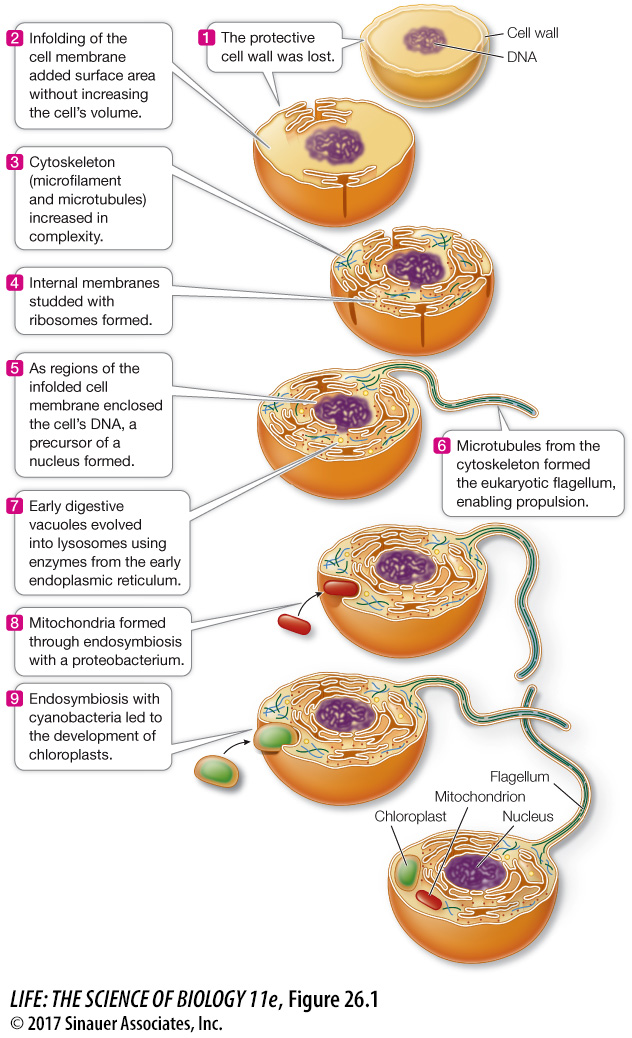The modern eukaryotic cell arose in several steps
Several events were important in the origin of the modern eukaryotic cell (Focus: Key Figure 26.1):
The origin of a flexible cell surface
The origin of a cytoskeleton
The origin of a nuclear envelope, which enclosed a genome organized into chromosomes
The appearance of digestive vacuoles
The acquisition of mitochondria and chloroplasts via endosymbiosis
focus: key figure

Question
Q: How could you use DNA sequencing and phylogenetic analysis to test the endosymbiotic origins hypothesis for mitochondria and chloroplasts?
DNA sequences of genes that are found in all genomes (such as the ribosomal RNA genes) can be used to connect organelles to their endosymbiotic ancestors. If the organelles did not evolve through endosymbiosis, then we would expect homologous copies of organellar and nuclear genes from the same species to cluster in a phylogenetic tree. However, this is not the case. Instead, phylogenetic analyses show that the ribosomal RNA genes of mitochondria in eukaryotes are more closely related to homologous genes from proteobacteria than to eukaryotes, and the ribosomal RNA genes of chloroplasts in eukaryotes are more closely related to homologous genes from cyanobacteria than to eukaryotes. These analyses provide convincing evidence in support of the endosymbiotic origins hypothesis.
FLEXIBLE CELL SURFACE We presume that ancient prokaryotic organisms, like most present-
Consider the possibilities open to a flexible cell without a firm wall, starting with cell size. As a cell grows larger, its surface area-
CHANGES IN CELL STRUCTURE AND FUNCTION Other early steps that were important for the evolution of the eukaryotic cell involved increased compartmentalization and complexity of the cell (see Figure 26.1, steps 3–
The development of a more complex cytoskeleton
The formation of ribosome-
studded internal membranes, some of which surrounded the DNA The enclosure of the cell’s DNA in a nucleus
The formation of a flagellum from microtubules of the cytoskeleton
The evolution of digestive vacuoles
Until a few years ago, biologists thought that cytoskeletons were restricted to eukaryotes. Improved imaging technology and molecular analyses have now revealed homologs of many cytoskeletal proteins in prokaryotes, so simple cytoskeletons evolved before the origin of eukaryotes. The cytoskeleton of a eukaryote, however, is much more developed and complex than that of a prokaryote. This greater development of microfilaments and microtubules supports the eukaryotic cell and allows it to manage changes in shape, to distribute daughter chromosomes, and to move materials from one part of its larger cell to other parts. In addition, the presence of microtubules in the cytoskeleton allowed some cells to develop the characteristic eukaryotic flagellum.
The DNA of a prokaryotic cell is attached to a site on its cell membrane. If that region of the cell membrane were to fold into the cell, the first step would be taken toward the evolution of a nucleus, a primary feature of the eukaryotic cell. The nuclear envelope appeared early in the eukaryote lineage. The next step was probably phagocytosis—
ENDOSYMBIOSIS At the same time the processes outlined above were taking place, cyanobacteria were generating O2 as a product of photosynthesis. The increasing concentrations of O2 in the oceans, and eventually in the atmosphere, had disastrous consequences for most organisms of the time, which were unable to tolerate the newly oxidizing environment. But some prokaryotes evolved strategies to use the increasing O2, and—
554
At about this time, endosymbioses began to play a role in eukaryote evolution (see Figure 26.1, steps 8–
*connect the concepts You may wish to review the reactions of cellular respiration in Key Concept 5.3.
Photosynthetic eukaryotes are the result of yet another endosymbiotic step: the incorporation of a prokaryote related to today’s cyanobacteria, which became the chloroplast.